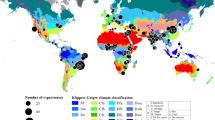Abstract
The success of many intercropping systems in North America is attributable to the generation of a short term return from an agricultural crop during the early, unprofitable years of a longer term crop that is fruit, nuts or wood. This highly-efficient use of land and related profitability are important not only in the development of intercropping systems per se, but also in other applications which have tremendous potential independent of profitability. For example, intercropping can be effectively used during the establishment phases of hardwood plantations where it is essential to have a high level of weed control, the costs of which are often recovered with the agricultural production. Intercropping can also be used to grow trees rapidly and with a form that can be easily integrated into recreational or park situations, or urban fringe areas. In an urban context, intercropping can be used to grow trees in agricultural areas that are likely to be developed where traditional forestry options are not appropriate and the value of younger, thrifty trees may enhance property values far in excess of the cash value of the wood.
Similar content being viewed by others
References
Bezkorowajnyj PG (1990) Testing manure slurry as a cattle repellent in an agro-silvopastoral system. Unpublished M.Sc. thesis, University of Guelph, Guelph, Ontario, Canada, 110 pp
Garrett HE and Kurtz WB (1983) Silvicultural and economic relationships of integrated forestry-farming with black walnut. Agroforestry Systems 1; 245–256
Gordon AM and Williams PA (1991a) Agroforestry Research and Development Final Annual Report to the Ontario Ministry of Agriculture and Food — land Stewardship Program. University of Guelph, Department of Environmental Biology, March 31, 1991, 177 pp
Gordon AM and Williams PA (1991b) Intercropping valuable hardwood tree species and agricultural crops in southern Ontario. For Chron 67(3): 200–208
Hollingsworth B (1979) Hybrid poplar dual cropping. Internal Ont Min of Nat Res tech rept for the Hybrid Poplar Program, Brockville, Ontario, Canada, 8 pp
Kincaid WH, Kurtz WB and Garrett HE (1982) A silvicultural-economic model for black walnut. In: Black Walnut for the Future, pp 122–129. USDA For Ser Gen Tech Rep NC- 74, No Cent For Exp Stn, St Paul, MN
Knowles RL (1989) New Zealand experience with silvopastoral systems. Keynote paper, session 7, International Conference on Agroforestry, University of Edinburgh, Edinburgh, Scotland, 23–28 July, 1989
Kurtz WB, Thurman SE, Monson MJ and Garrett HE (1991) The use of agroforestry to control erosion — financial aspects. Forestry Chronicle 67: 254–257
Padoch C and de Jong W (1987) Traditional agroforestry practices of native and ribereno farmers in the lowland Peruvian Amazon. In: Gholz H, ed, Agroforestry: Realities, Possibilities and Potentials, pp 179–194. Martinus Nijhoff Publishers, 227 pp
Raintree JB (1991) Agroforestry in North America: the next generation, keynote address. In: Williams PA, ed, Proceedings of the First Conference on Agroforestry in North America, August 13–16, 1989, Guelph, Ontario Canada, pp 1–14
Steppler HA and Nair PKR (1987) Agroforestry: A Decade of Development. ICRAF, Nairobi Kenya, 265 pp
Vergara NT (1987) Agroforestry: a sustainable land use for fragile ecosystems in the humid tropics. In: Gholz H, ed, Agroforestry: Realities, Possibilities and Potentials, pp 7–19. Martinus Nijhoff Publishers, 227 pp
von Althen FW (1991) Afforestation of former farmland with high-value hardwoods. Forestry Chronicle 67: 209–212
Author information
Authors and Affiliations
Rights and permissions
About this article
Cite this article
Williams, P.A., Gordon, A.M. The potential of intercropping as an alternative land use system in temperate North America. Agroforest Syst 19, 253–263 (1992). https://doi.org/10.1007/BF00118783
Issue Date:
DOI: https://doi.org/10.1007/BF00118783




